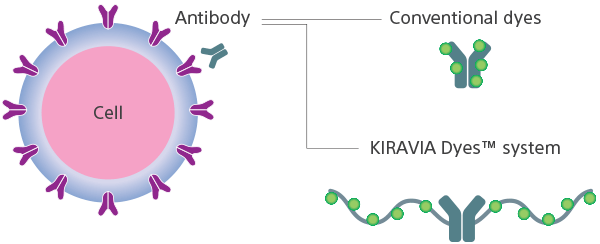KIRAVIA Dyes™

The KIRAVIA Dyes™ are organic polymers with fluorescent dyes loaded precisely on a novel backbone developed by Sony, based on proprietary technology. This family of fluorescent dyes can be used on both spectral and conventional flow cytometers. Designed for ease of use, KIRAVIA Dyes do not require a special buffer system or sample preparation protocol.
Features
- Novel backbone technology to enable development of dyes with improved properties
- Ready for use in a wide range of life science applications
To further life science research in the regenerative medicine and immunology fields, Sony has released a portfolio of dyes conjugated to antibodies, giving researchers new choices for panel design. The conjugates can be used in a variety of multicolor applications.
KIRAVIA Blue 520™
The first dye in the family, KIRAVIA Blue 520™ (KB520), is excited by the 488-nm laser, with a maximum signal at 520 nm. Recommended for experiments on flow cytometers equipped with a 488-nm laser, this novel dye is ideal for panels with dim expressors. Its excellent brightness provides better discrimination and resolution. KB520 can replace fluorochromes that use the 530/30 (FITC) detector. In high parameter experiments KB520 can be used to detect antigens with a variety of abundance levels, but would ideally be saved for an antigen with ubiquitous and/or variable expression levels in the sample. The KB520 conjugated antibodies exhibit higher stability and brightness compared to FITC conjugates.

Figure 1.
The figure shows a cell with surface antigens to which the antibodies can bind. The structure of the KIRAVIA Dyes allow for the fluorochromes to be precisely positioned for increased brightness.

Figure 2. KIRAVIA Blue 520 Excitation and Emission
Sony KB520 fluorochrome is a blue laser excitable dye with a 497 nm excitation max and 520 nm emission max.

Figure 3. KIRAVIA Blue 520 Emission
KIRAVIA Blue 520 emission spectra on the SA3800 Spectral Analyzer.

Figure 4.
Comparison of KB520 (green) with Alexa Fluor® 488 (blue) using the ID7000™ Spectral Cell Analyzer. The KB520 dye is brighter than Alexa Fluor® 488.

Figure 5. CD3 Positive and Negative Cell Populations
Analysis of Human PBMCs CD3 KB520 populations using the ID7000 Spectral Cell Analyzer.

Figure 6.
Human PBMCs were stained with CD3 KB520 (blue) and CD3 Alexa Fluor® 488 (red) and compared vs CD8 Brilliant Violet 421 (BV421) on the BD LSR Fortessa™ analyzer.